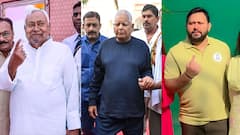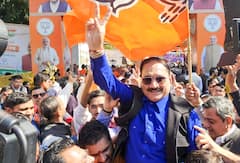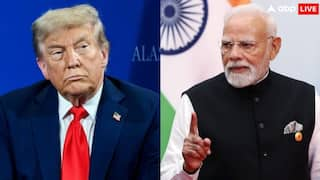Gujarat Watch: The Patel Conundrum In 2022 Assembly Elections
Though all parties woo the Patidars equally, the community is no longer the BJP’s single biggest block of voters.

Ahmedabad: The 2017 Gujarat Assembly election was a watershed in several ways. Not so much because it was the BJP’s worst performance at 99 out of 182 seats since its first victory in 1995, and the Congress’ best of 77 seats after its first defeat in 1995, as much as the churning in the Patidar community that was principally responsible for this.
It was for the first time in Gujarat’s socio-politico-economic history since the formation of the BJP in 1980 that the Patidars swung their electoral choices in favour of the Congress, which was an anathema for them and all higher castes like Brahmins and Baniyas. The Patidars, the Brahmins, and the Baniyas were at the forefront of two massive anti-reservation agitations in Gujarat in 1980 and 1985 when Gujarat was ruled by Chief Minister Madhavsinh Solanki of the Congress.
ALSO READ | On A Break From Bharat Jodo Yatra, Lone Ranger Rahul Gandhi In Poll-Bound Gujarat With Much At Stake
It is these communities, especially the Patels, that produced several BJP leaders and the party catapulted to political significance – to such an extent that Gujarat came to represent the party’s laboratory and the best state to spread its wings nationally. Gujarat has had five Patidar chief ministers, including Anandiben Patel, Keshubhai Patel, Chimanbhai Patel, and Babubhai Patel, since its formation on May 1, 1960.
The community consolidated behind the BJP after the Congress’ KHAM (Kshatriyas, Harijan, Adivasi, Muslim) formula, which sharpens the caste divide. So, the Patidar voters were not only integral to the BJP’s electoral growth but also constituted its financial muscle. These very Patidars, who drove and financed the huge anti-quota agitations in Gujarat, revolted against the BJP with their new generation demanding reservation in government jobs and educational institutions. What is more, the Hardik Patel movement also caused a churning among the other castes in the state.
This is the reason that among the BJP’s top priorities after its close shave with defeat in 2017 was to break these troupes of Patidar youngsters and neutralise their agitation. This is the reason Hardik Patel is now in the BJP and even contesting the elections from his hometown Viramgam on a saffron ticket.
But by now, and significantly, the Patidars are no longer the en bloc voter base of any political party, including the BJP, the Congress, and now the Aam Aadmi Party (AAP), while all of them are trying to woo them. The number of Patidar contestants from each party itself is a good enough indicator.
ALSO READ | Gujarat Watch: AIMIM, The Elephant In The Congress Room
25% Of All BJP, Congress, AAP Candidates Are Patidars
The BJP has fielded 45 Patidars, the Congress 42, and the AAP has nominated 46 Patel candidates in a House of 182. Simply stated, nearly 25% of all candidates of the three key parties are Patidars. The numbers are a clear indication that the BJP can’t completely rely on the Patidars and this explains why the ruling party is trying to drive a wedge among the tribal voters in 27 constituencies reserved for the Scheduled Tribes. There are 13 other constituencies where Adivasis are in a sizeable number who can tilt the balance for either party if their vote doesn’t get split.
This is the reason Prime Minister Narendra Modi formally launched his campaign after the election dates were announced by the Election Commission from the tribal-dominated Valsad district in South and did the same thing on his very next visit. Simultaneously, the BJP’s Gaurav Yatra from the tribal region was thrown open by Union Home Minister Amit Shah.
Numerically just about 12% of Gujarat’s population, the Patels were big landlords and represented the powerful agrarian community who had struck it rich with cash crops like groundnut and cotton, to later spreading their wings in almost all key businesses of Gujarat, including diamond, pharma, engineering, brass parts as well as grew to become huge realtors.
The community, largely divided among the Leuva and Kadwa sub-castes who otherwise remain perennially at loggerheads, draw their political – and therefore bargaining and browbeating – strength from their control of key educational and religious institutions as well as businesses and prime real estate.
It was in the 1950s that the Patidars struck gold after the Saurashtra Land Reforms Act, 1952, came into being when they got occupancy rights on the lands they cultivated to tenant cultivators. This is how the once economically backward classes got co-opted into the mainstream and it is with them that several Hindu sects like the Swaminarayans of various factions the Swadhyaya Pariwar and several such prospered to accord them a Hindu religious identity. This status got enlarged after a majority of Gujarati settlers in the US and even the UK became cash-rich NRIs consistently repatriating funds to their near and dear ones.
It was their prosperity and riches that made Patels a hugely influential community though they are not in big numbers, and so they are the most sought after community for all political parties. They are concentrated in the central Gujarat districts of Kheda and Anand, Mehsana and Patan in North Gujarat, and Saurashtra’s districts of Rajkot, Amreli, and Morbi districts.
According to the political parties, 16 seats in the state with 9 among them being in Saurashtra, 3 in North Gujarat and 4 in Surat are controlled out-an-out by the Patels, but there are as many as 90 seats where Patidars have the numbers to alter results. A good number of seats used to be invariably won by the BJP, but now they are expected to split between all three parties.
There are some 50 seats where Patidars account for more than 20% of voters, and the BJP and the Congress won 28 and 22 respectively in 2017, as against the corresponding numbers of 36 and 14 in 2012. An analysis by Lokniti-CSDS (Centre for Study of Developing Societies) conducted after the 2017 polls found that 68% Kadva Patels and 51% of Leuva Patels voted for the BJP as compared to 78% and 63% in 2012.
It was also brought out that the Congress’s vote share among the Patidars increased in 2017 with as many as 27% of Kadvas and 46% Leuvas voted for the party in 2017 compared to 9% and 15% in 2012. Inflation, joblessness and affordable education, and a stable and business-friendly government are some of the concerns of the community this election season.
With the Patidar agitation no longer in play in the 2022 elections, the BJP is hopeful that community members who shifted to the Congress will return to its fold.
So, Patels remain a conundrum unlike in the past.
(The writer is a veteran journalist and Founder Editor, Development News Network (DNN), Gujarat)
(The opinions, beliefs, and views expressed by the various authors and forum participants on this website are personal and do not reflect the opinions, beliefs, and views of ABP News Network Pvt Ltd.)


































